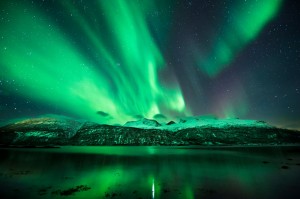 Sweeping bands of color, curtains of light that stay still or move slowly through the heavens, intense colors flashing through the night sky—the northern lights are an inspirational site. Ranging in color from green to red to yellow to blue and technically called the aurora borealis, this powerful phenomenon has been watched with awe for thousands of years. Before modern observation techniques and technology revealed the true cause (the collision of charged particles and atoms in Earth’s upper atmosphere), different cultures theorized that they were signs from ancestral spirits, natural deities, or God. Given the unique beauty of the event, a supernatural explanation is by no means surprising.
Sweeping bands of color, curtains of light that stay still or move slowly through the heavens, intense colors flashing through the night sky—the northern lights are an inspirational site. Ranging in color from green to red to yellow to blue and technically called the aurora borealis, this powerful phenomenon has been watched with awe for thousands of years. Before modern observation techniques and technology revealed the true cause (the collision of charged particles and atoms in Earth’s upper atmosphere), different cultures theorized that they were signs from ancestral spirits, natural deities, or God. Given the unique beauty of the event, a supernatural explanation is by no means surprising.
 As a traveler, how can you get the opportunity to experience the aurora yourself? There are multiple things you can do to increase your odds. The first is to get to the right latitude—somewhere between 10o and 20o from the magnetic pole. This belt extends around the earth at all longitudes, so there are sites in northern Europe, Asia, and North America that are appropriate for viewing. For those in the southern hemisphere, there’s also the aurora australis. Because there is less landmass at the correct latitudes, it is less common to view the southern lights, but it is by no means impossible. Check out high altitude spots at the southern latitudes of South America, Australia, New Zealand, and northern latitudes of Antarctica.
As a traveler, how can you get the opportunity to experience the aurora yourself? There are multiple things you can do to increase your odds. The first is to get to the right latitude—somewhere between 10o and 20o from the magnetic pole. This belt extends around the earth at all longitudes, so there are sites in northern Europe, Asia, and North America that are appropriate for viewing. For those in the southern hemisphere, there’s also the aurora australis. Because there is less landmass at the correct latitudes, it is less common to view the southern lights, but it is by no means impossible. Check out high altitude spots at the southern latitudes of South America, Australia, New Zealand, and northern latitudes of Antarctica.
 Once in the right latitudinal zone, you’re still subject to normal weather patterns. Clouds are the bane of aurora hunters, so finding a location that enjoys clear weather is paramount. This is often the case in places surrounded by mountains that break up cloud cover, and experience high winds that push them away. Light pollution is another key factor, as city lights make it much more difficult to see astronomical phenomena like the aurora. Staying in a small village or even out in the wilderness (if you can handle the cold) is generally necessary to get the best possible view. The moon causes another form of light pollution, so when its cycle leaves it smaller or invisible your odds are increased. The time of year is another variable factor that can affect your odds, but judging the best dates is a very inexact science. The spring and fall equinoxes of March and September have the highest odds of geomagnetic storms, which ignite the aurora. Early in those same months, the Earth is in its best location in relation to the sun to maximize the effect of solar wind, which causes the aurora to shimmer and move. However, these seasonal factors do not correlate precisely with auroral activity, so there are other unknown factors at play as well.
Once in the right latitudinal zone, you’re still subject to normal weather patterns. Clouds are the bane of aurora hunters, so finding a location that enjoys clear weather is paramount. This is often the case in places surrounded by mountains that break up cloud cover, and experience high winds that push them away. Light pollution is another key factor, as city lights make it much more difficult to see astronomical phenomena like the aurora. Staying in a small village or even out in the wilderness (if you can handle the cold) is generally necessary to get the best possible view. The moon causes another form of light pollution, so when its cycle leaves it smaller or invisible your odds are increased. The time of year is another variable factor that can affect your odds, but judging the best dates is a very inexact science. The spring and fall equinoxes of March and September have the highest odds of geomagnetic storms, which ignite the aurora. Early in those same months, the Earth is in its best location in relation to the sun to maximize the effect of solar wind, which causes the aurora to shimmer and move. However, these seasonal factors do not correlate precisely with auroral activity, so there are other unknown factors at play as well.
The hunt essentially comes down to just being in the right place at the right time, which no expert can accurately predict. And if going that far afield to find the aurora seems unfeasible, you may still get lucky—the phenomenon has been known to occur at more temperate latitudes when certain conditions are met. There is a peak in sunspot activity every 11 years that may be your ticket to seeing them closer to home. Wherever you experience them, it’s guaranteed to be rewarding. Good luck!






